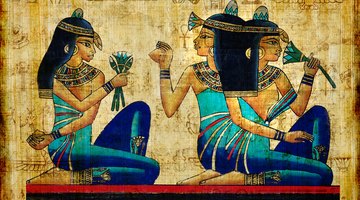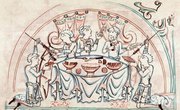Ancient Egypt, as we think of it today, began in 5000 B.C. when farmers began to establish small villages on the banks of the Nile, according to the Oriental Institute at the University of Chicago. For thousands of years, this society flourished. Ancient Egyptians built great pyramids and temples that continue to be marvels of engineering and developed hieroglyphics, a complex system of writing. Various pharaohs, kings and queens ruled Egypt until Cleopatra VII died in 30 B.C., and Egypt became part of the Roman Empire. Girls held important roles in ancient Egypt and could grow up to occupy high ranks in society, as Cleopatra did.
Familial Ties
Family was very important in ancient Egyptian society, and girls were valued just as highly as boys. Children respected their parents and gave equal importance to the lineages of their mothers and fathers when tracing their heritage. Parents doted on their children and celebrated childbirth. However, infant mortality was presumed to be high in ancient Egypt because of unsanitary conditions and only a basic understanding of disease. Mothers often nursed children until they were at least four years old to help protect them from illness.
Playing
Dolls and toys were abundant in Ancient Egypt, as evidenced by the many toys found in tombs. Wooden carvings of animals that could be pulled by a string were popular, as were dolls made of wood, clay and fiber. As girls grew older, they were expected to shadow their mothers and help with household chores. They would spend free time swimming and playing several board games, including senet and mehen. Banquets were popular social events in ancient Egypt; families and friends would often gather to share bread, beer and vegetables while watching dancers or listening to music.
Class Distinctions
Young girls in the peasant class lived very different lives than young girls in the upper classes. Peasant girls had a much lower life expectancy than wealthy girls and were expected to help labor in the house and fields. Girls were also expected to help raise the other children in their households. No girls received formal schooling in ancient Egypt, but some girls in the upper classes were able to read and write, indicating they had some form of tutoring.
Marriage
Girls were considered ready for marriage not long after they began menstruating. Marriages were usually social arrangements that helped regulate property, and grooms often gave gifts to the bride’s family. However, any property girls owned before marriage was theirs to keep in the event of a divorce. Ancient Egyptians typically had large families and girls often became pregnant soon after getting married, according to Douglas J. Brewer, professor of anthropology at the University of Illinois, Urbana, and Emily Teeter, curator of ancient Egyptian and Nubian antiquities at the Oriental Institute Museum, University of Chicago, authors of "Egypt and Egyptians."
Related Articles
References
Resources
Writer Bio
Sarah Cairoli began her writing career in 2002, as a reporter for the "High Country Independent Press" in Belgrade, Mont. She then spent two years writing and editing for an online publishing company, and earned her master's degree in English from Northern Arizona University. Cairoli also writes for "Bozeman Magazine."











